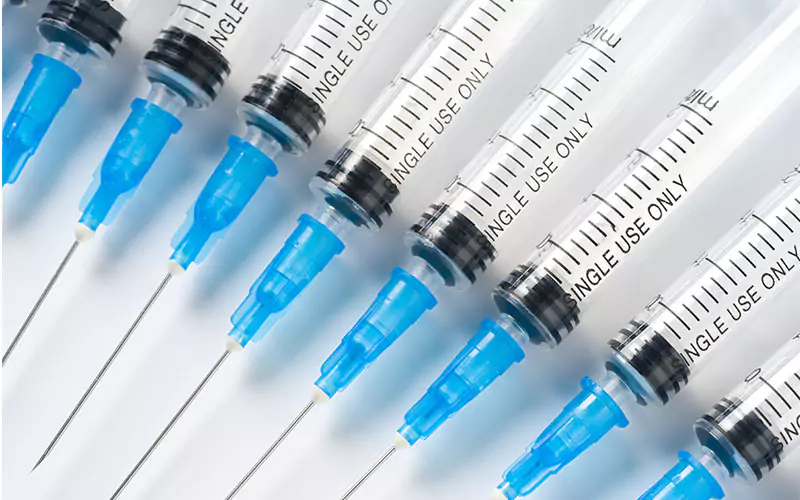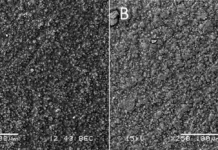By Dianna Brodine, managing editor, UV+EB Technology
UV disinfection is in the spotlight as the world continues to grapple with effective mitigation of the spread of COVID-19. A search for the word “disinfection” on Amazon brings up several pages of UV light sanitizers, UVC cleaners, UV disinfection boxes and portable UV lamps… Whether these products are effective or are shipped to consumers with adequate health and safety information would be the subject of another article. However, there’s no doubt that disinfection technologies utilizing ultraviolet lamps have been brought to the attention of the general public.
UV curing technologies also have seen increased usage since the onset of the pandemic, although without much fanfare. From 3D printing of swabs used for testing to syringes for eventual vaccine use, UV curing plays an important role behind the scenes.
UV+EB Technology spoke with Chris DeMell, global medical market manager for IDS, a division of ITW; Carlos Alvarez, vice president of global sales – curing, and Pamela Lee, sr. product manager, OmniCure, Excelitas Technologies; and Kevin Joesel, director of sales – UV, and Lonnie Murphy, sales manager – North America West, Heraeus Noblelight America, to learn more about the ways UV curing has influenced the medical market.
Q: How has the pandemic accelerated medical market growth?
“The medical market has seen tremendous growth with the onset of COVID-19, due to the various products that are required to deal with the pandemic, such as testing kits, catheters and drug delivery components,” said DeMell. “And, keep in mind that almost all of the coronavirus-related uses are in addition to the everyday needs that the medical market serves. People still need all the products that they needed before the pandemic. Production has been increased, and the forecast is that this will continue for the next several years.”
Increased demand for disposable products that are needed during the pandemic has spurred demand for UV curing equipment as well. “The traditional advantage of UV curing – speed of cure with 100% immediate property development for many formulations – is valued when used in medical applications,” said Joesel.
Murphy added, “The adhesives and bonding subsegment has seen an increase as a lot of the test kits for COVID-19 are plastic-to-plastic bonded. In fact, needle bonding, single-use catheters, tube sets – these all can be bonded with UV. And some of the processes used to make masks involve UV curing, too.”
Alvarez agreed, saying “What we’re seeing is our product being used to build or facilitate the solution for COVID-19 issues. For instance, our spot curing product is being used with catheters, endoscopy products and needle assembly. In all of these cases, a UV adhesive is used.”
The medical market demand driven by the pandemic isn’t likely to subside soon, as DeMell added, “The other major piece of the puzzle has to deal with the pending vaccinations that are planned. The syringe market has a large production capacity, however it needed to be enhanced greatly to meet current needs as well as the upcoming surge of demand. Major medical companies have been acquiring additional equipment to expand production and start stocking up. This growth will push the market for at least the next few years.”
Q: What medical applications will see higher rates of growth in the next three to five years?
“In addition to the products that are being ramped up for the pandemic, the largest areas of growth have focused on pharma-related drug delivery,” said DeMell. “Ever since the introduction of auto-inject pen technology, such as the Epi-Pen, pharma companies have embraced the use of patient-delivered drug delivery. These can be single use for emergency use, or multi-use devices.”
Patient-delivered applications also are a trend seen by Murphy. “Needle bonding has been big for our customers, and there are coatings that go onto the outside of catheters that are a growth area, too. But I also see transdermal patches and hydrogels, which are all UV technologies now, increasing.
Alvarez said, “It’s interesting because if I would have taken you back seven years, catheters were fairly simple devices, but today the amount of complexity added to catheters has increased drastically – and that’s as a result of the public’s demand for non-invasive surgery. We continue to see the areas of catheters and endoscopy expand, as well as personalized diagnostic devices.”
Joesel added, “These new applications are driven by the formulators, and we’re here to help and support their explorations with as many options as we can.”
Q: What about medical marking applications?
“UV has been a growing technology within the medical market for curing pad print inks as compared to traditional solvent inks,” said DeMell. “Much of this has to deal with quality, as well as production rates. Solvent inks can require additional cure times, depending on the formulations, and speed is paramount with any automated production systems. UV offers a full cure immediately, which allows for either bulk production without fears of ink transfer, or turnkey solutions that allow for decoration followed by assembly and packaging. Recently, COVID-19 test kits had to be designed, requiring clear markings and indicators that typically are addressed with pad printing.”
Alvarez said, “In the medical industry, traceability, indexing and the ability to track batches and lots are very important.” In high-production environments, UV curing during the marking process keeps the manufacturing line moving without worries that the inks will smudge as the product moves to fill or assembly.
Q: What is the role of UV equipment manufacturers in medical market advances?
“The true driver in all of this is the formulator,” said Joesel. “As an equipment supplier of all the different platforms – UVC, broadband emitters, arc lamps, LEDs, infrared – we provide the means. The UV units that are used for testing and evaluation in laboratories are the same equipment used on the production line, so it’s directly scalable, which is a very important attribute in the medical industry.”
Murphy added, “Because we have so many types of UV photon emitters, we’re involved in the development of equipment that the end users or formulators can use to develop their process. We’re also working with the chemistry suppliers and the raw material suppliers, and we have our own chemists on staff. We put a lot of resources into trying to understand the chemistry, and our strength is in the application centers we have around the world. We’re positioned to support the formulators.”
Excelitas also has a materials science lab, which offers validation of the technology with the formulations. Lee added, “In these types of applications, accuracy, repeatability and a high-quality cure are required. Our products have been popular in medical device manufacturing because we have closed-loop feedback capabilities that allow customers to validate the process and ensure standardization.”
Alvarez concluded, “As these devices get more complicated, the materials change and the adhesives changes. We’re trying to put the formulation and a UV curing instrument together in a way that solves the customer’s problems. Because we don’t make any of the formulations, we tend to be a little more objective about the solutions.”






